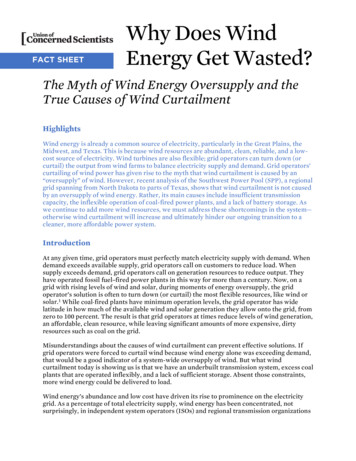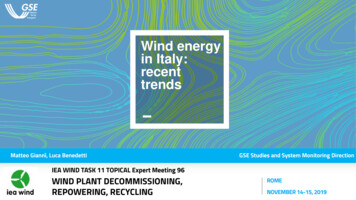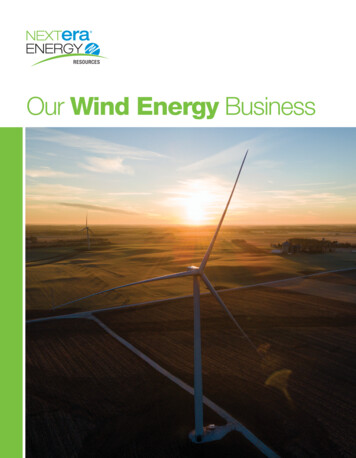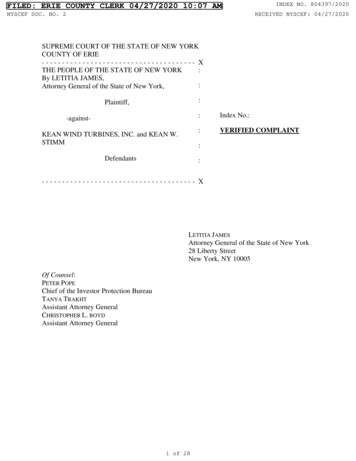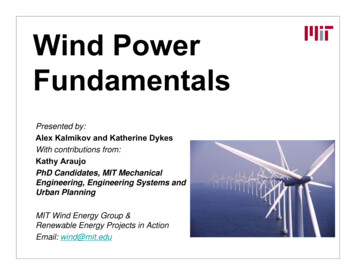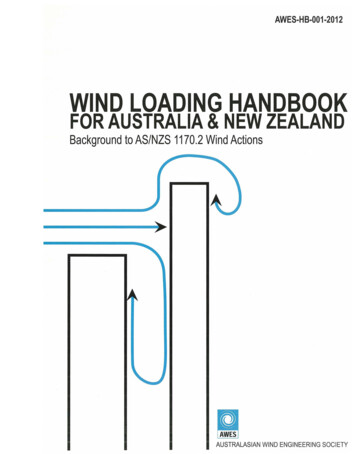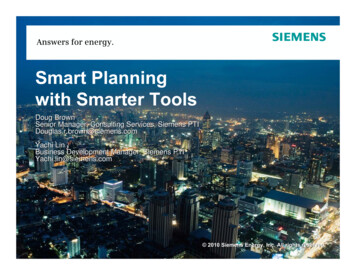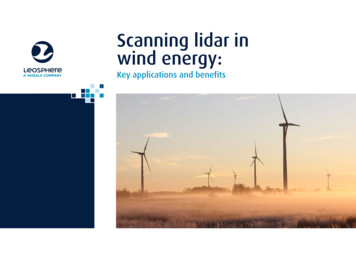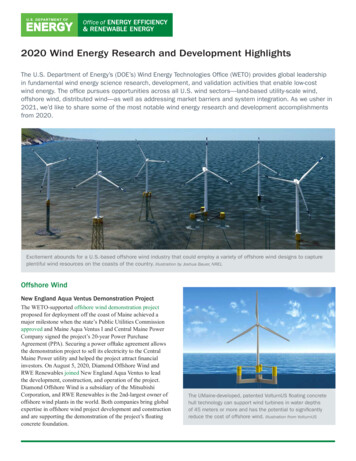
Transcription
2020 Wind Energy Research and Development HighlightsThe U.S. Department of Energy’s (DOE’s) Wind Energy Technologies Office (WETO) provides global leadershipin fundamental wind energy science research, development, and validation activities that enable low-costwind energy. The office pursues opportunities across all U.S. wind sectors—land-based utility-scale wind,offshore wind, distributed wind—as well as addressing market barriers and system integration. As we usher in2021, we’d like to share some of the most notable wind energy research and development accomplishmentsfrom 2020.Excitement abounds for a U.S.-based offshore wind industry that could employ a variety of offshore wind designs to captureplentiful wind resources on the coasts of the country. Illustration by Joshua Bauer, NRELOffshore WindNew England Aqua Ventus Demonstration ProjectThe WETO-supported offshore wind demonstration projectproposed for deployment off the coast of Maine achieved amajor milestone when the state’s Public Utilities Commissionapproved and Maine Aqua Ventus I and Central Maine PowerCompany signed the project’s 20-year Power PurchaseAgreement (PPA). Securing a power offtake agreement allowsthe demonstration project to sell its electricity to the CentralMaine Power utility and helped the project attract financialinvestors. On August 5, 2020, Diamond Offshore Wind andRWE Renewables joined New England Aqua Ventus to leadthe development, construction, and operation of the project.Diamond Offshore Wind is a subsidiary of the MitsubishiCorporation, and RWE Renewables is the 2nd-largest owner ofoffshore wind plants in the world. Both companies bring globalexpertise in offshore wind project development and constructionand are supporting the demonstration of the project’s floatingconcrete foundation.The UMaine-developed, patented VolturnUS floating concretehull technology can support wind turbines in water depthsof 45 meters or more and has the potential to significantlyreduce the cost of offshore wind. Illustration from VolturnUS
Lidar Buoy DeploymentIn September 2020, WETOleveraged funding from the Bureauof Ocean Energy Management(BOEM) to deploy two offshorewind research buoys off the coastof California in water that is 2,000–3,000 feet deep. This marks thefirst time the buoys are gatheringmeteorological and oceanographicmeasurements off the West Coast.The buoys will collect data for ayear to support BOEM decisionson potential leasing of wind energysites off California’s coastline andbring a new renewable energysource to the state. The deploymentfollows a 1.3-million upgradeto install more powerful lidars aswell as making the associated datamanagement system open sourceto foster easier access by the windscientific community at large.U.S. Department of Energy lidar buoy deployed off Morro Bay, California. Photo from AXYSTechnologies and Pacific Northwest National Laboratory (PNNL)National Offshore Wind R&D ConsortiumThe National Offshore Wind R&D Consortiumwas established by DOE and the New York StateEnergy Research and Development Authority withinvestments of 20.5 million each to fund highimpact research projects that lower the costs of U.S.offshore wind and support supply chain development.State agencies in Maryland, Virginia, andMassachusetts have since contributed funding to theConsortium, resulting in a total investment of around 46 million. The Consortium’s first RFP resultedin 20 awards totaling 17.3 million, and in 2020 itannounced its second Request for Proposals (RFP) forindustry-prioritized offshore wind R&D topics.15-MW Reference TurbineThe IEA Wind 15-MW reference turbine is rated for a 15-megawatt turbinewith a height of 150 meters and a rotor diameter of 240 meters.Illustration by Joshua Bauer, NREL2In early 2020, DOE’s National Renewable EnergyLaboratory (NREL), through an internationalcollaboration funded by WETO, developed a15-megawatt (MW) offshore wind referenceturbine—an open-access design of a complete windturbine system that researchers use to evaluatethe performance and cost of proposed systemmodifications. The reference turbine is widely usedand accommodates multiple software tools andfeatures separate modules for fixed-bottom windturbines in shallow water and deep-water, floatingwind turbines.
design new wind turbine blades with a focus on wake researchat the DOE/Sandia Scaled Wind Farm Technology facility inTexas. The patented innovation changes how much the air slowsdown as it passes through the wind turbine rotor. The resultof this blade design is a wake that disappears more quickly,which allows wind turbines to be spaced closer together withoutsacrificing efficiency—lowering costs by increasing energyproduction per unit of land area used and decreasing the amountof electrical lines and roads needed to connect them.Carbon Fiber Composites for BladesUtility-scale land-based wind development continues to rapidlyexpand in the United States. Photo by Dennis Schroeder, NRELDOE’s Sandia National Laboratories, Oak Ridge NationalLaboratory, and Montana State University demonstrated thecommercial viability of a novel cost-competitive carbon fibercomposite material for use in wind turbine blades. The analysisfound commercial viability and system-level benefits for usingcarbon fiber composites to reduce the overall cost of wind energyand manufacture long, slender wind turbine blades. The projectrevealed a 25% blade mass reduction when using carbon fiberspar caps compared to fiberglass. While wind manufacturershave historicallyavoided using carbonfiber due to its highercost, the new textilebased carbon fibermaterial used for sparcaps in this studycost 40% less thancommercial carbonCarbon fiber is considered afiber—potentiallykey technology to enable theenabling the broadercontinued growth in wind turbineadoption of carbonblade length for the land-basedfiber materials in windand offshore machines of theturbine blade designfuture. Photo from Getty Imageswith the potential toLand-Based Wind and Cross-CuttingWind TechnologyHigh-Efficiency, Lightweight Wind Turbine GeneratorsWETO supported three projects to develop next-generationwind turbine drivetrain technologies that will facilitate thecontinued growth of wind turbines. Lightweight generators areimportant because the size and weight of the generator impactthe weight and cost of the wind turbine tower and foundation,as well as the specialized equipment needed to transport andinstall the large components. General Electric (GE) Researchdesigned a prototype high-efficiency ultra-light low-temperaturesuperconducting generator that leverages investments from themagnetic resonance imaging (MRI) industry, eliminates the needfor foreign-sourced rare earth materials, and reduces generatormass as compared to current technologies. WEG EnergyCorporation developed a high-efficiency permanent magnetdirect drive lightweight generator to integrate into its existingplatform. AmericanSuperconductorCorporationdeveloped ahigh-efficiencylightweight windturbine generatorthat incorporateshigh-temperatureDOE is funding projects to developsuperconductinghigh-efficiency, lightweight wind turbinematerials togenerators, all of which are developingreplace permanentdirect drive technologies. Graphic frommagnets in theWindpower Engineeringgenerator rotor.reduce system costs.Open-Source Performance Optimization ToolWith funding from WETO, NREL released a new version ofits FLOw Redirection and Induction in Steady State (FLORIS)model for wind plant performance optimization. FLORIS,which was co-developed by NREL and the Delft University ofTechnology, is an open-source platform available for downloadand collaborative development. The latest update leverages newmodeling tools to enhance FLORIS’s ability to accurately designand analyze wind plant control strategies for larger arrays ofturbines. Since 2018, more than 2,000 users have accessed thetool to inform turbine operation as well as wind plant design. Byoptimizing flow control strategies like wake steering, FLORISenables existing wind energy facilities to improve productivityand increase profits. For more information on the new model, seethe FLORIS 1.1.14 documentation or read the new discussionpaper in Wind Energy Science.Patented Blade DesignWith funding from WETO, DOE’s Sandia National Laboratories(Sandia) developed a wind turbine blade design that wouldallow turbines to be installed closer to one another, due to afaster-dissipating, and less interfering, wake. The idea originatedduring the National Rotor Testbed project, which sought to3
Microgrids, Infrastructure, Resilience, and AdvancedControls LaunchpadThe Microgrids, Infrastructure Resilience, and AdvancedControls Launchpad (MIRACL) project is part of WETO’sportfolio of investments aimed at enabling wind technology tobe an affordable, accessible, and compatible distributed energyresource (DER). DERs are increasingly used by individuals,businesses, and communities to cost-effectively build resilientelectric infrastructure and enhance the capabilities of localdistribution grid operations. In 2020, this collaborative researchproject—which includes DOE’s National Renewable EnergyLaboratory, Pacific Northwest National Laboratory (PNNL),Sandia National Laboratories, and Idaho National Laboratory—established a high-speed data link called the MIRACL Hub toleverage nearly a billion dollars’ worth of research capabilitiesand DER infrastructure across the four laboratories. This enablesresearch, development, and industry validation of DER designand planning tools, components, and hybrid energy systemsacross multiple scales and configurations in geographicallydiverse operating conditions. A 2020 PNNL report found thatmany user-facing distribution modeling and simulation tools donot accurately calculate the performance or reflect the temporal,locational, and resilience value of distributed wind—identifyinga future area of work for MIRACL R&D.With its solar panels and residential wind turbines, CBF’sBrock Environmental Center produces nearly twice as muchenergy as it needs using distributed energy technology.Photo by Prakash Patel, PNNLDistributed WindCompetitiveness Improvement ProjectNREL, with funding from WETO, works with dozens of smallbusinesses across the United States to advance wind technologyas a distributed energy resource through the CompetitivenessImprovement Project (CIP). Launched in 2013, the CIP supportsmanufacturers of distributed wind technology—typically smalland medium-scale wind turbines—through competitivelyawarded, cost-shared projects aiming to: 1) optimize designs forincreased energy production and grid support; 2) test turbinesand componentsto nationalstandards to verifyperformance andsafety; and 3)develop advancedmanufacturingprocesses toreduce hardwarecosts. Between2013 and 2020,NREL awarded 36subcontracts to 20A photo of a Bergey Excel 15 windcompanies, totalingturbine. Photo from Bergey Windpower 7.75 million offunding, whileleveraging 3.79 million in additional private-sector investment.In August 2020, DOE selected eight projects to receive 2.6million in DOE funding, bringing the total DOE commitmentto over 10 million, and leveraging over 5 million in industrycost-share.Defense and Disaster Deployable TurbineThe WETO-funded Defense and Disaster Deployable Turbineproject evaluates the technical and market potential for rapidlydeployable wind energy systems to meet the energy needs ofdefense and disaster-response activities. A 2020 report foundthere is a significant opportunity for wind turbines to provideon-site power and overcome the risks and limitations of existingdiesel-powered generators used to support foreign defensemissions or humanitarian activities, such as disaster response.The report’s analysis suggests that low wind speed optimizedand rapidly deployable wind turbines, when integrated withbattery storage, could be used to offset 80% of diesel generatoruse at certain forward operating bases.Partnerships identify opportunities for rapidly deployablewind energy systems to power national defense and disasterrecovery missions worldwide. Illustration by Mike Bergey, BergeyWindpower4
NREL’s new 19.9-MW substation, used for ARIES utility-scale grid integration research. Photo by Dennis Schroeder, NRELGrid IntegrationCybersecurity RoadmapMore than 50,000 wind turbines with a combined capacityof over 100 gigawatts operate in the United States, creating aserious need to protect wind infrastructure from cyberattacks.With support from its national laboratories, WETO published theRoadmap for Wind Cybersecurity, which outlines the increasingchallenges of cyber threats to the wind industry, its technologiesand control systems, and present activities and best practices thatthe wind industry can use the improve cybersecurity.Grid Services Field DemonstrationAs energy providers explore new ways to reliably integraterenewable energy sources into the electric grid, they can nowlook to wind plants to supply more than just power. Withsupport from WETO, research collaborators NREL, AvangridRenewables, the California Independent System Operator, andGeneral Electric conducted a series of tests showing that windtechnologies have the necessary capabilities to provide a fullsuite of grid services and respond to the dynamic needs of theelectric grid. The findings from these tests—performed in anactive grid-operating environment over several days—werepromising. They will inform future research that explores howactive power control capabilities for inverter-connected plantsthat combine wind, photovoltaic solar, and energy storagetechnologies could further accelerate the movement toward theelectric grid of the future.Continental Transmission StudyThrough the Interconnections Seam Study, NREL joined nationallab, university, and industry partners to examine the value ofincreasing transfers of electricity across the U.S. electric gridusing high-voltage direct-current transmission. The study,sponsored by EERE and the DOE Office of Electricity, quantifiesthe costs and benefits of strengthening the connections (or seams)between the Eastern and Western Interconnections, which couldcreate a more integrated power system and increase efficientdevelopment and use of the nation’s abundant energy resources,including solar, wind, and natural gas.Publicly available results show how plant-level controls can beused to balance the grid. Photo from Avangrid RenewablesTools To Optimize Transmission UtilizationDOE’s Idaho National Laboratory (INL) licensed its GeneralLine Ampacity State Solver (GLASS) software to WindSimAmericas. GLASS is a crucial piece of INL’s weather-basedDynamic Line Rating (DLR) methodology, which is a tool thatuses real-time weather data and forecasts to dynamically rateoverhead transmission lines, optimizing the use of electricityinfrastructure for the integration of wind energy.Stitching together regions of the U.S. power grid can enhanceour ability to harness resources and balance loads acrossthe country. WI Western Interconnection; EI EasternInterconnection; ERCOT Electric Reliability Council of Texas.Map by NREL5
Sam Dollar and Houdini test bird flightpaths around wind turbines at NREL’s Flatirons Campus. Photo by Jason Roadman, NRELEnvironmental Research, Siting, andWorkforce DevelopmentBat Deterrent System CommercializedA WETO-supported bat deterrent system developed by NRGSystems, Inc., of Vermont has been successfully commercialized.NRG announced in July 2020 that Siemens Gamesa RenewableEnergy (SGRE) was providing installation support of the batdeterrent system, which uses nacelle-mounted ultrasoundgenerating devices and a controller integrated with the turbine’sSCADA system to deter bats from wind turbines. SGRE hasinstalled the system on its wind turbines in Ontario, Canada, andMaui, Hawaii.Incorporating an Unmanned Aircraft System, researchers atNREL worked with PNNL to advance ThermalTracker softwareto improve wildlife impact minimization efforts for both landbased and offshore wind. Photo by Werner Slocum, NREL3D Thermal Tracking of Birds and BatsCommissioned by WETO, DOE’s Pacific Northwest NationalLaboratory developed ThermalTracker-3D, a stereovisionsolution for evaluating flight tracks and other data on birds andbats around offshore wind turbines. The technology uses thermalvideo that records movement day or night, even in limitedvisibility conditions. ThermalTracker-3D continuously transmitssatellite data showing if and when birds and bats are active nearproposed wind farms, without the need for researchers to travelto the deployment site.Two NRG devices mounted on top of a wind turbine nacelle,one pointing upward toward the blades, and one pointing tothe right of the turbine. Photo by Harrison Gatos, NRG Systems6
U.S. Wind Turbine DatabaseWETO and Berkeley Lab, in partnership with the U.S.Geological Survey, made significant improvements to theU.S. Wind Turbine Database, which contains data from morethan 65,000 wind turbines spanning 43 states plus PuertoRico and Guam. Since its launch in 2018, the dataset has beenviewed more than 4.5 million times and continues to serve asthe authoritative data source on wind energy deployment foragencies evaluating the impacts of wind development, includingits impact on radar missions. In 2020, as an extension of theDatabase, a dataset of unbuilt turbines in various stages ofdevelopment, was prepared for use in radar impact assessmentsand to estimate possible cumulative impacts of wind projectbuildout in the United States.Collegiate Wind Competition Goes VirtualThe U.S. Department of Energy Collegiate Wind Competitionprepares students from multiple disciplines to enter thewind energy workforce by providing real-world technologyexperience. After four days of intense virtual presentations, DOEannounced the winners of the 2020 Collegiate Wind Competition.Judged by a panel of wind industry experts, the winner of theTurbine Digital Design contest was California State UniversityMaritime Academy and the winner of the Project Developmentcontest was James Madison University. Three new collegiateteams and 10 returning teams from previous competitions wereselected to participate in the 2021 Collegiate Wind Competition,which will include a focus on outreach and adaptability.By evaluating both bald and golden eagle responses toaudiovisual stimuli, researchers uncover insights to drivefurther wind deployment by protecting these species frompossible wind turbine impacts. Photo by Dennis Schroeder, NRELEagle Research To Mitigate ImpactsIn 2020, Purdue University and the University of Minnesotaeach concluded WETO-funded research focused on exploringeagle physiology to improve the effectiveness of deterrents usedaround wind energy facilities. Purdue evaluated eagle hearing andvision ranges, while the University of Minnesota assessed eaglehearing. Purdue found that eagles have a blind spot near the topsof their heads that hinders their ability to see ahead, when lookingdown and hunting. This finding suggests the need for a deterrentthat is sufficiently alarming to an eagle to cause it to look upwhen hunting. Purdue also found that blue/indigo and orange/redwould be most visible to eagles against various backgrounds. Thestudy concluded that golden eagles are more likely to respond tovisual signals, whereas bald eagles are more likely to respond toa combination of sight and sound. The University of Minnesotaexplored hearing range and response to various auditory stimuli,including eagle vocalizations, finding that eagle deterrentdevelopers should consider varying frequency and volumepatterns to achieve the strongest and least-habituated responses.For highlights of historical wind energy R&Daccomplishments over the past several decades, seeWind Energy Technologies Office Lasting Impressions.As part of their work in the 2021 Collegiate WindCompetition, students conducted industry and communityoutreach through this year’s new Connection CreationContest. Photo by Werner Slocum, NRELFor more information, visit: energy.gov/eere/windDOE/GO-102021-5518 January 20217
National Offshore Wind R&D Consortium The National Offshore Wind R&D Consortium was established by DOE and the New York State Energy Research and Development Authority with investments of 20.5 million each to fund high-impact research projects that lower the costs of U.S. offshore wind and support supply chain development.

